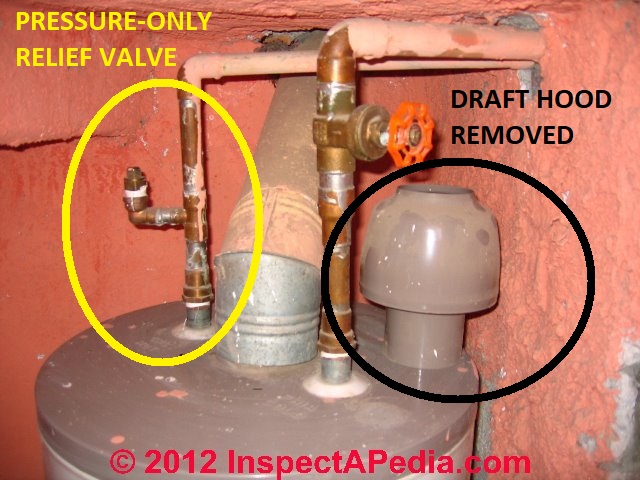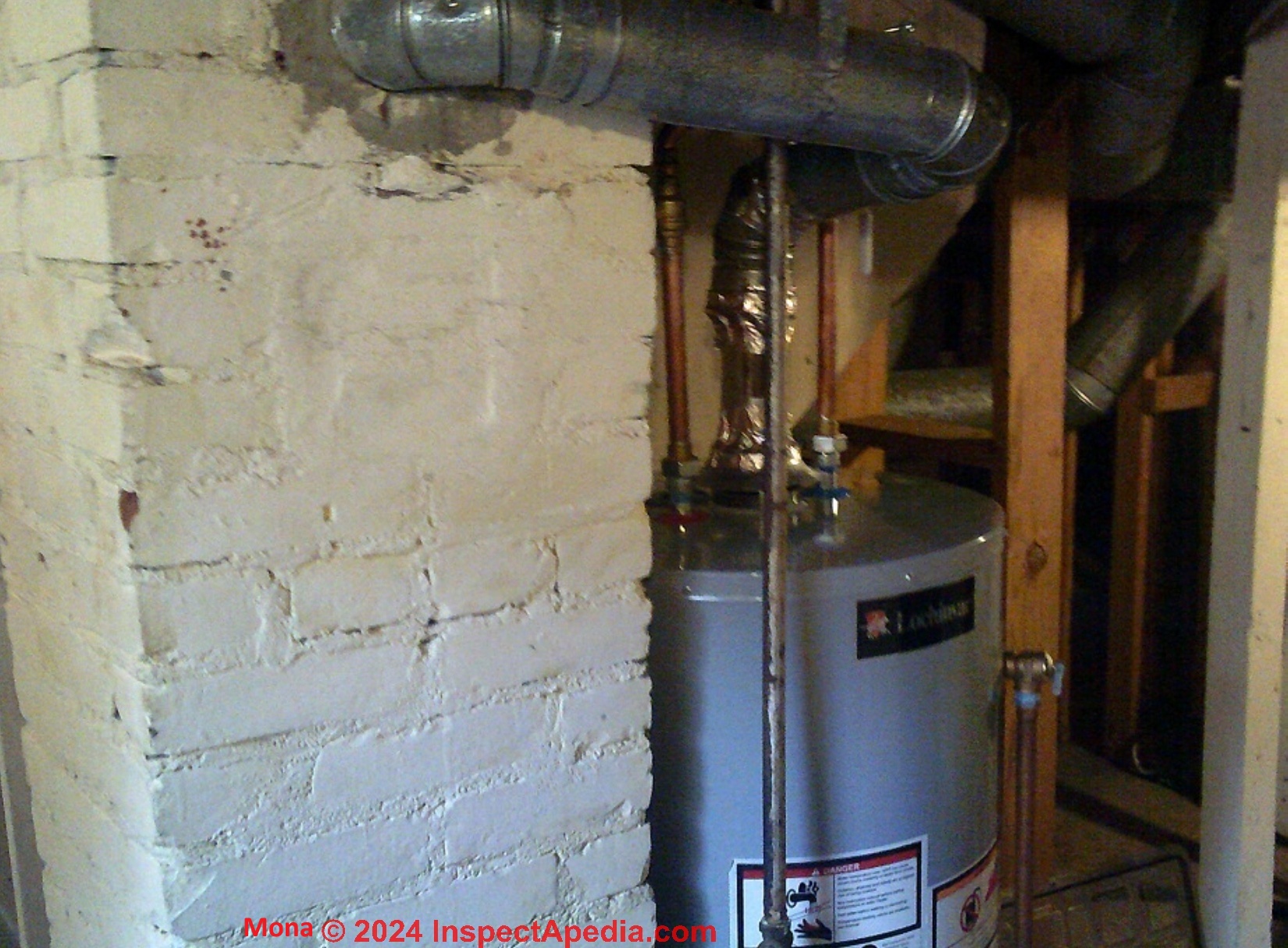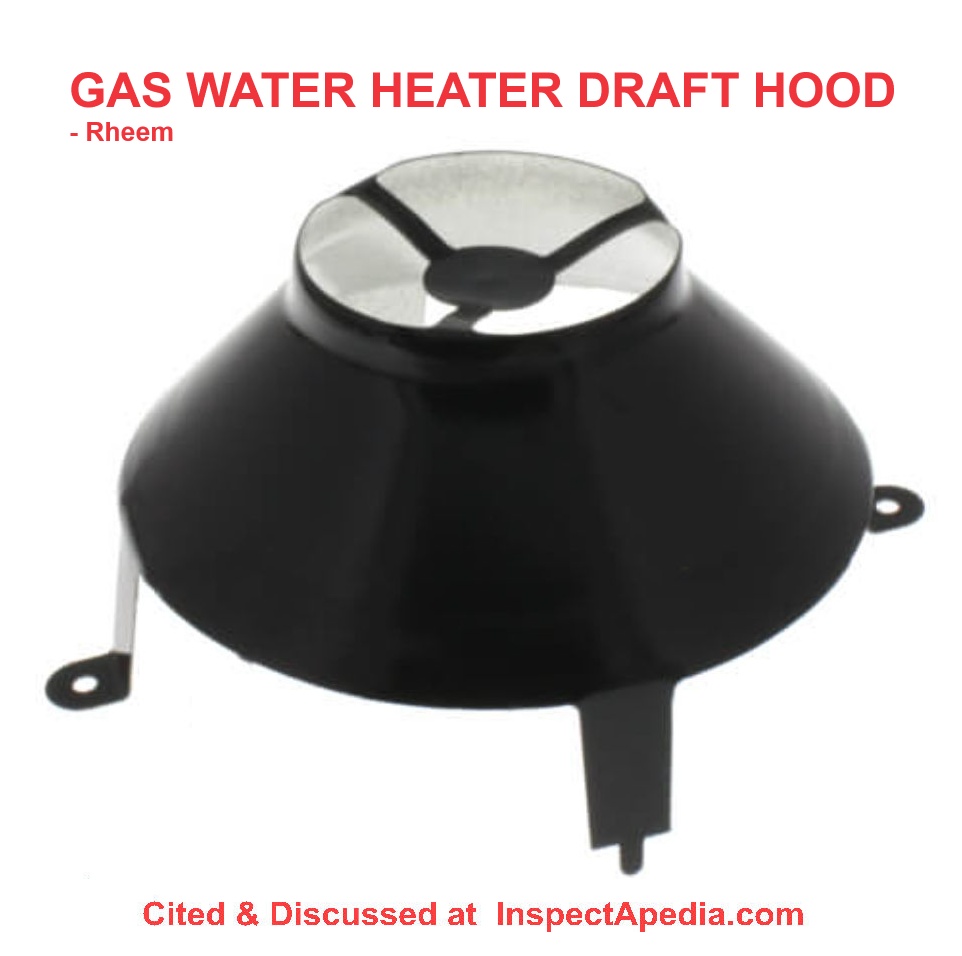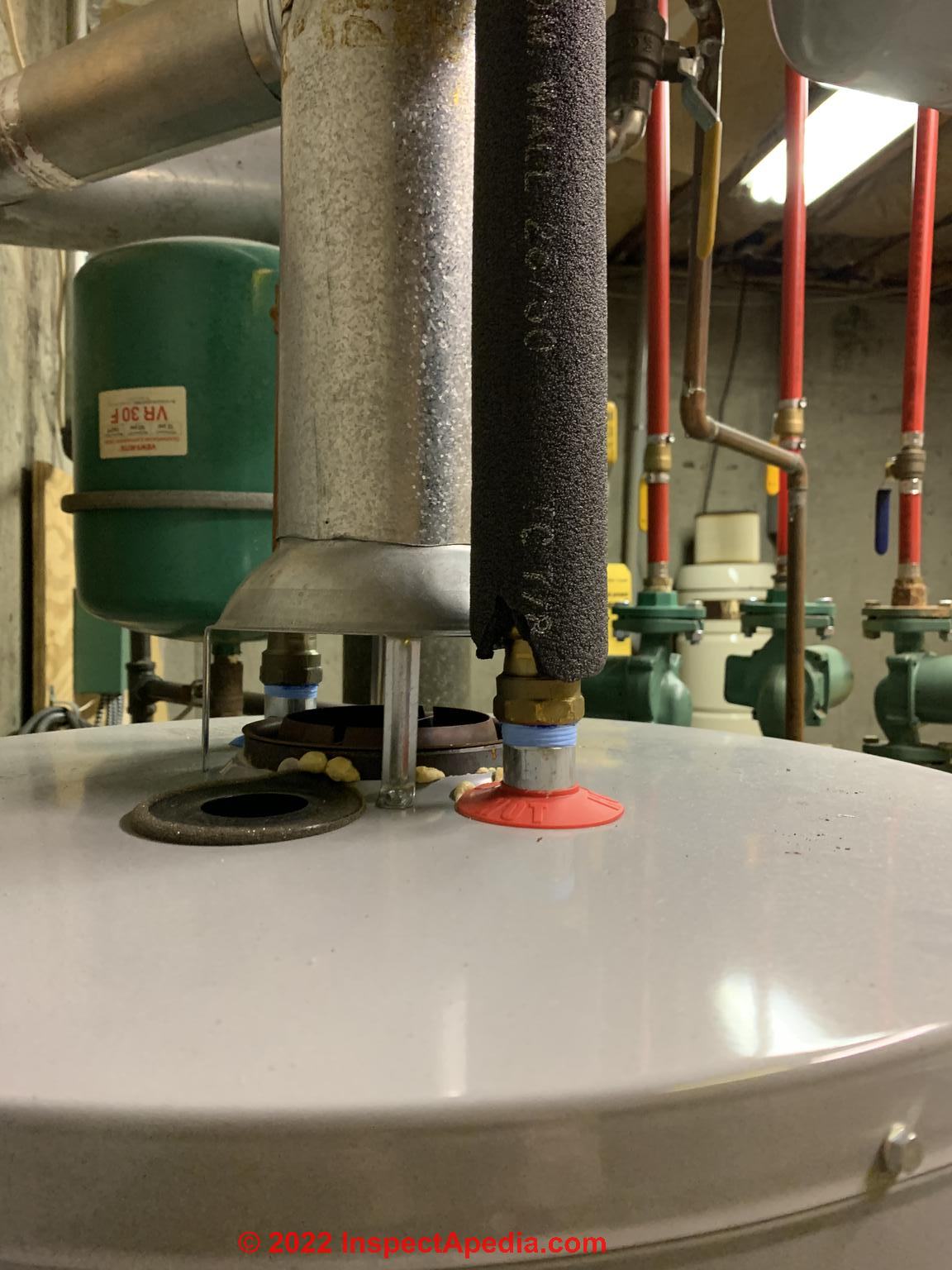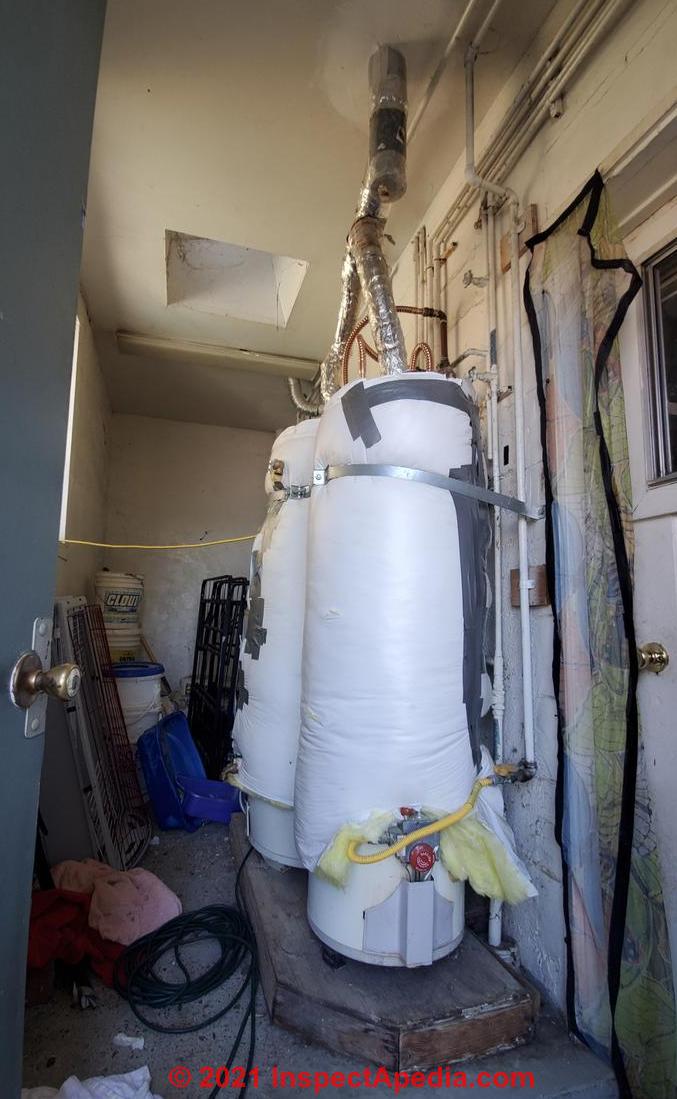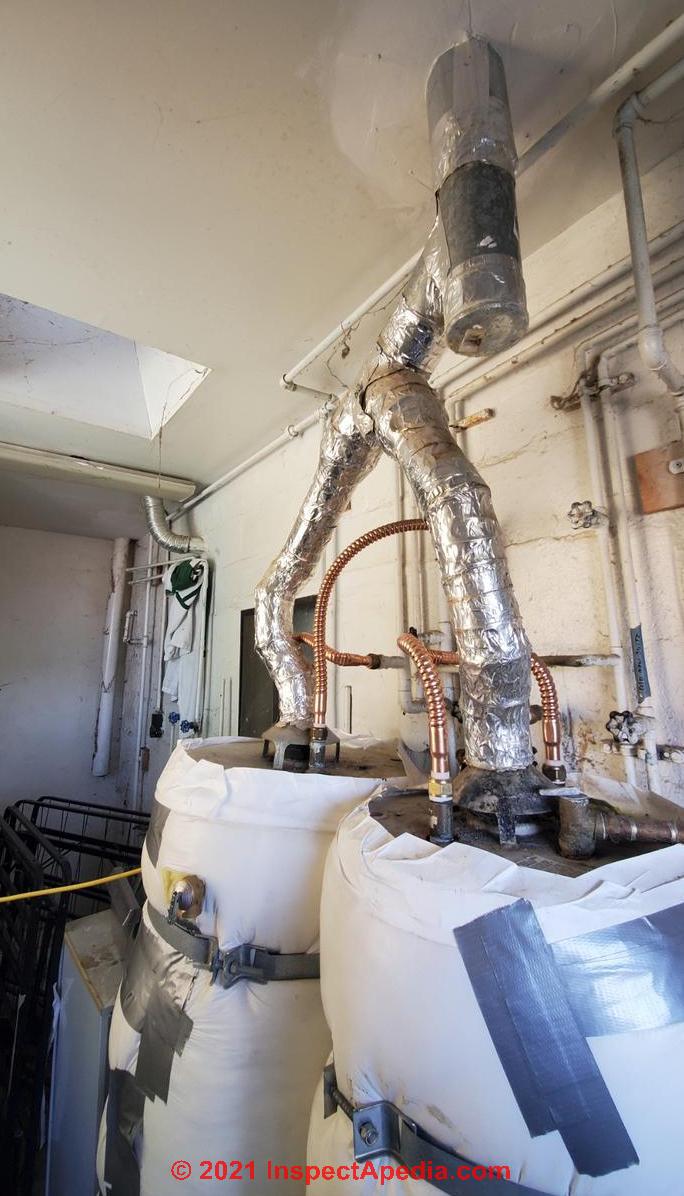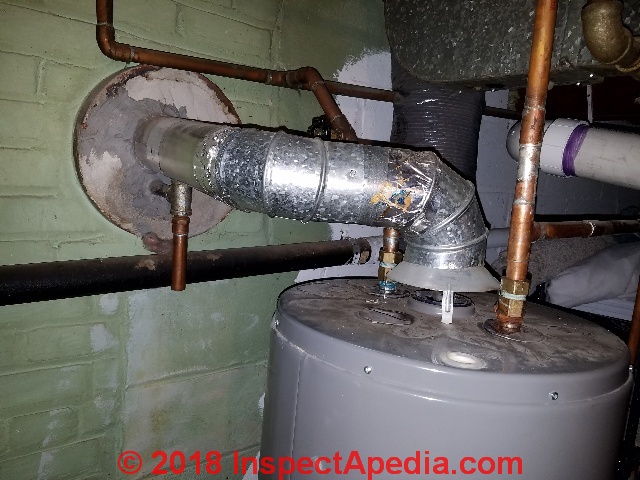 Unsafe Gas Water Heater Vent Examples
Unsafe Gas Water Heater Vent Examples
Gas water heater venting safety warnings
- POST a QUESTION or COMMENT about unsafe venting or chimneys for gas fired water heaters
Examples of unsafe gas fired water heater vent pipe installations are illustrated and discussed here.
The natural gas fueled water heater shown at page top is improperly vented, lacking the recommended minimum 12" of vertical rise before the elbow and vented directly into a large masonry flue where it cannot develop adequate draft.
Watch out: This heater installation may be unsafe.
InspectAPedia tolerates no conflicts of interest. We have no relationship with advertisers, products, or services discussed at this website.
- Daniel Friedman, Publisher/Editor/Author - See WHO ARE WE?
Examples of Improper & Unsafe Gas-Fueled Water Heater Chimneys & Vents
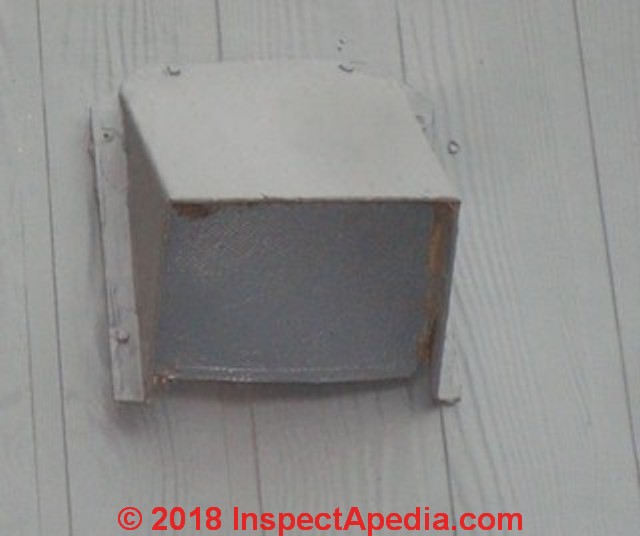 Question: gas-fueled water heater horizontal vents terminate in a dryer vent flapper: is this acceptable?
Question: gas-fueled water heater horizontal vents terminate in a dryer vent flapper: is this acceptable?
I have recently inspected a large apartment complex with more than 100 units, each served by an individual gas-fired water heater.
The water heaters that I saw (I haven't seen all of them yet) vent horizontally out through a building side wall.
[Click to enlarge any image]
There the heaters terminate in either a painted-over (and so blocked) screen or a clothes dryer flapper-type vent.
In my opinion these water heaters are not safely vented. A building manager asserted that because the apartments have carbon monoxide detectors the installations are "Safe".
I think that proper venting is a necessary safety correction for the property and, knowing the property owner I'm confident that the proper repairs will be made.
Below is what I wrote.
Is there more I could or should say? - A.P. ASHI Home inspector by private email 2018/02/09
Many gas fueled water heater exterior vent covers at xxx are dangerously blocked. Many (maybe 30) vents are obstructed by tight meshes (mosquito netting?) which are painted, many are covered with louvered dryer vent covers (which are designed for the forced air pressure of a dryer vent, not for the gentle flow of a water heater flue), and some are crushed and some have animal nesting.
The argument that the units have carbon monoxide detectors should not satisfy you because UL listed carbon monoxide detectors are not designed to detect low levels of carbon monoxide and because low levels of carbon monoxide can make people sick. Please see the photo below and see:
https://www.health.harvard.edu/diseases-and-conditions/carbon-monoxide-poisoning-
Also, attached are two pages from a random water heater installation manual
Please contact me with questions or comments, - AP
Reply: No AP, the natural draft gas fired water heater vent you show through a sidewall is improper and unsafe.
Venting a Natural Draft Gas Fired Water Heater Out Through a Sidewall & Into a Dryer Vent Termination
P. In my OPINION you've met the requirement of pointing out an unsafe condition. What I provide below in amplification will provide more authoritative citations and excerpts on the topic of proper venting of gas fired water heaters.
In your note you could consider expanding this phrase:
... should not satisfy you because ...
because I want to make clear that the "you" is not a legal, competent, nor acceptable authority and because I'd want to have made clear that there are grave liabilities and life-safety risks at stake.
A longer explanation of the hazards around a blocked or improperly-designed gas fueled water heater might be excerpted from the following:
... cannot satisfy your assertion that the building and its mechanical systems are safe and acceptable.
The water heater vents and vent terminations are incorrectly designed, improperly installed, and blocked. CO detectors are intended as a last line of defense against CO poisoning.
CO detectors are never accepted as a substitute for proper heater installation and venting. The building code for your area (citation needed), amplified by the manufacturer's instructions (citation needed) do not permit a water heater to be improperly nor ultimately un-vented.
That condition forces combustion gases into the building's interior and risks forcing them into occupied spaces.
The attached installation instructions from the manufacturer of these water heaters require a minimum vertical rise in the water heater exhaust flue as well as a proper UL listed chimney cap or termination for safe venting of combustion products.
There are grave liabilities and risks involved in violating basic mechanical and safety standards.
A water heater whose exhaust vent is inadequate due to insufficient chimney height or worse, blocked by an improper termination is unsafe regardless of whether or not CO is detected. Even a small change in a building, opening or closing a door or window can lead to illness or to a fatality.
Example:
Watch out: "FAILURE TO PROPERLY VENT THIS WATER HEATER CAN CAUSE AN EXPLOSION, FIRE, OR CARBON MONOXIDE POISONING WHICH MAY RESULT IN PROPERTY DAMAGE, PERSONAL INJURY OR DEATH.", source: INSTALLATION, OPERATION, AND SERVICE MANUAL RESIDENTIAL STORAGE TYPE GAS WATER HEATER - source: American Water Heater company cited below.
Attachment: sketch from this company showing acceptable water heater venting details.You will see that in no case is short horizontal sidewall venting acceptable for a conventional gas fired water heater. That is because the system will not develop adequate draft to vent flue gases outdoors.
OPINION: When a water heater vented in that manner also has the vent exit blocked by painted screen material or by use of an improper vent termination such as one intended for a clothes dryer (not listed nor approved for water heater use) the venting can be nearly 100% blocked.
Such installations are improper and unsafe. The details for acceptable water heater venting are in the manufacturer's instructions as well as in the model codes cited below.
The gas-fueled water heater shown below is discussed
where we provide a checklist and table of gas fired water heater safety points.
Water Heater Safety Warning: Scorch Marks at Heater Top
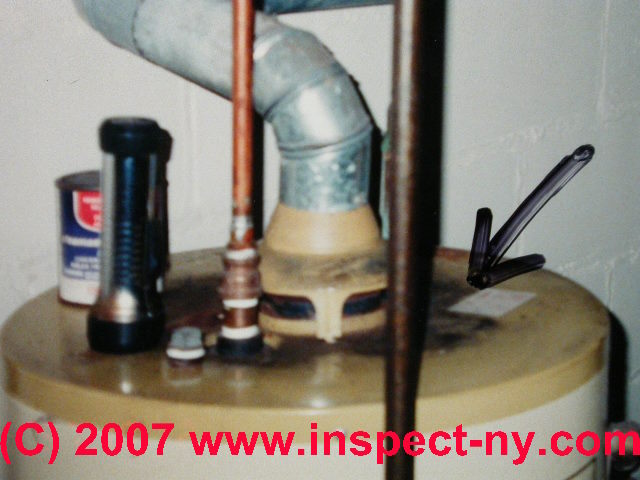 In the photo the scorch marks are a tell-tale indicator that there has been back-drafting at this gas water heater.
In the photo the scorch marks are a tell-tale indicator that there has been back-drafting at this gas water heater.
The following might best be handled as an attachment demonstrating that you are not simply stating an opinion you are citing applicable building codes and thus law that pertains. (You don't give the country, state, city, or province or we could add local code citations).
Example:
Watch out: WARNING: Obstructed or deteriorated vent systems may present a serious health risk or asphyxiation." - source: "Instruction Manual for Residential Gas Water Heaters", State Water Heaters, retrieved 2018/02/09, original source: http://www.statewaterheaters.com/lit/im/res-Gas/184115-000.pdf
Authority: This gas-fired water heater is design certified by CSA INTERNATIONAL under American National Standard/CSA Standard for Gas Water Heaters ANSI Z21.10.1 • CSA 4.1 (current edition).
The installation must conform with this manual, Local Codes and with the current edition of the National Fuel Gas Code, ANSI Z223.1.
Example:
Watch out: Carefully inspect the venting system of a replacement water heater installation before connecting to the venting system. All joints in the vent connector must be securely fastened with screws and fit tightly together.
Inspect the venting system for signs of deterioration (rust and perforation) and replace any sections that are not in good condition.
The chimney must be lined and in good condition. Check to make sure the venting system is properly sized for the water heater. If the venting system was previously sized for another gas appliance that has been removed, the venting system may now be too large.
Refer to the latest edition of the National Fuel Gas Code (ANSI Z223.1-latest edition), or in Canada, the Natural Gas and Propane Installation Code (B149.1-00 latest edition) for the correct sizing of venting systems and common venting with another gas appliance.
Do not vent this water heater into the venting system of another gas appliance designed to vent under positive pressure. The water heater should be installed as close as practical to the venting system to minimize the vent connector length required.
Refer to local codes for the distance limitations on vent connector lengths. At the completion of the water heater installation, the burner and venting system must be checked for proper operation with all other commonly vented appliances in operation.
Check for spillage of flue products around the outside relief opening of the draft hood after several minutes of operation.
The flame from a match should be drawn into the draft hood. Do not use the water heater or connected equipment if spillage is detected until the problem is corrected.
Refer to the latest edition of the National Fuel Gas Code, or in Canada, the Natural Gas and Propane Installation Code for complete details on the “Procedure to Be Followed to Place Equipment in Operation”. - source: Bradford White Water Heaters, retrieved 2018/02/09, original source: http://www.bradfordwhite.com/sites/default/files/product_literature/238-44219-00G.pdf
Other examples of improper and unsafe gas water heater venting
Draft hood removed from water heater
Above: the water heater installer removed the draft hood to squeeze the water heater into place, and the only safety device is a remote pressure-only type relief valve.
Water heater too tall for location
Below we show a close-up of heat damage around the draft hood of a gas-fueled water heater installed in a Minneapolis home.

As the homeowner pointed out, that's because this water heater is essentially TOO TALL for this LOCATION [photo of the entire Rheem gas-fired water heater below a low ceiling].
Watch out: Do not terminate the vent pipe in a chimney that has not been certified for this purpose.
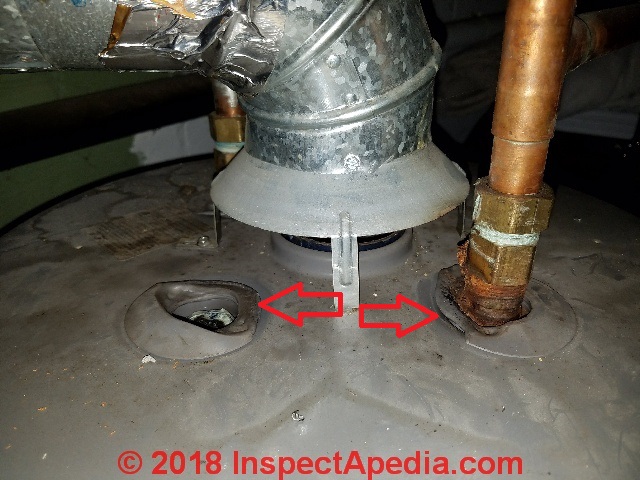
But in our OPINION even with a 12" vertical rise this heater would not vent adequately because it is directly-vented into a large, otherwise unused masonry flue.
Watch out: in our experience and opinion, the direct termination of a gas fired water heater into a large masonry flue, as illustrated just above, is likely to give serious venting problems, particularly in cold weather when the heater is the only appliance venting into the chimney.
The lower-BTUH of a gas water heater (compared with a heating furnace or boiler) will very often be unable to heat the chimney interior sufficiently to develop a draft.
The result is a back-draft of combustion products out of the water heater's draft hood and into the building.
Such installations are potentially unsafe and risk carbon monoxide poisoning.
See CARBON MONOXIDE - CO.
...
Reader Comments, Questions & Answers About The Article Above
Below you will find questions and answers previously posted on this page at its page bottom reader comment box.
Reader Q&A - also see RECOMMENDED ARTICLES & FAQs
2024/09/25 Is this Foil Wrapped Gas Water Heater Vent Safe?
Is this normal gas water heater the vent OK - it looks strange with that wrapping with metal like a foil paper? - NYM - re-posted from private email.
Moderator reply: no that is not a safe gas water heater vent: it's vent diameter has been reduced: Carbon monoxide hazard
No that's not a normal gas water heater vent installation and it's possible that it is unsafe.
I say that because it appears to me that there is a short section of vertical vent piping immediately above the water heater that is smaller in diameter than the water heaters vent opening and smaller in diameter than the remaining water heater vent sections
That's the section that was wrapped in aluminum foil, probably because it was too small and was leaky and someone was trying to stop water heater exhaust from leaking out at the connections.
Watch out: The safety concern is that when you make the vent opening too small, the water heater may not vent properly and it could backdraft or leak dangerous flue gases into the home including carbon monoxide - potentially fatal.
What to do: So the first order of business to keep you safe is to be sure that you have working carbon monoxide detectors as well as fire and smoke detectors in your home.
Once that's assured then you still want the correct vent installed.
To be safest, turn off the gas supply to this heater until its vent has been repaired and the technician agrees that it is safe.
That can be done by a water heater installer or almost any other heating or plumbing technician.
Reader follow-up:
Thank you I am in lexington ky I want some one to inspect it and tell the company to come and get it I don't want the money please send me inspector to contact
Moderator Reply:
If you don't need and won't use this water heater, turn off its gas supply and then when it's convenient any plumber can remove it for you.
Are these two gas water heaters vented correctly?
This was the set up when we purchased the house about 4 years ago.
The water heaters are in the basement and the floor height is 8 ft. I thought that the horizontal connections were made because of the limited height. There might have been a mid-efficiency furnace connected to the same chimney stack at one point, but there was a high efficiency furnace when we bought the house.
We had an inspection done at the time of purchase and the inspector had no comments other than suggesting the water heaters may be due for a replacement because of the age.
I did the simple draft test with a match and the smoke did get pulled into the vent. I don’t smell smoke or gas when standing next to the water heaters. No signs of leaks or condensation around the joints.
This makes me think the venting was correct. I am asking here because the vent connections looked different from the standard material I found online. Appreciate your insights.- On 2023-10-18 by Anon
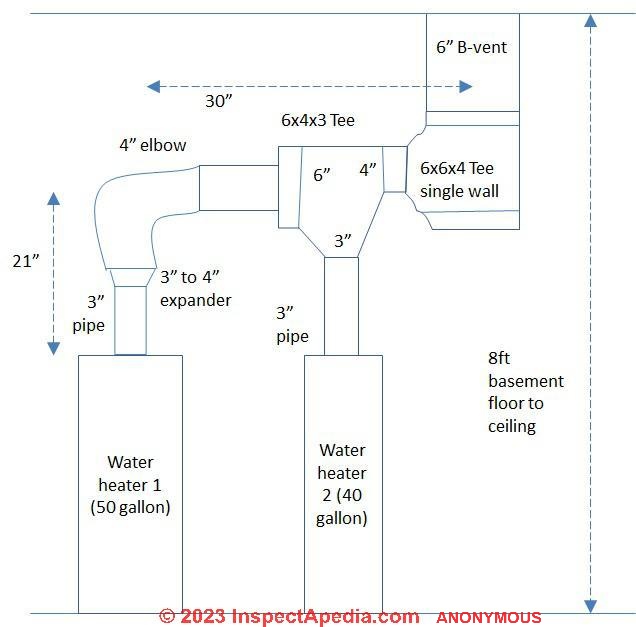
Reply by InspectApedia Publisher (mod) - two gas water heaters NOT vented correctly?,
@Are these two gas water heaters vented correctly?,
Your draft test was a good start but doesn't promise successful venting under all conditions.
That tee ahead of the chimney is backwards.
The 4,inch elbow was unnecessary,
And the chimney, when cold, may not successfully vent when just one of the water heaters turns on.
Looks like amateur work using whatever was at hand - a general warning to check whatever that person did.
In any event,
Make sure you have CO (carbon monoxide) detectors properly located and installed.Followup by Anonymous
@InspectApedia Publisher, thank you. This was very helpful.
What if I had the vent tee replaced with a 6x3x3 wye like in this attached picture? That 6x3x3 wye is readily available. Can one heater be connected to the very bottom of the flue pipe?
Or, am I required to use something like the double branch fitting shown on the right of the main diagram?
Reply by by InspectApedia Publisher (mod)
@Anonymous,
That will probably work but it is not a solution that I've seen before.More often people connect the water heaters via a tee that steps up in size, like the original, but reversed fitting in your first sketch.
Will this gas water heater vent pass a building inspection?
Hello ,well am a fix it it my self person type person and am putting the vent pipes myself ifor my water heater my question is does this look properly placed am asking cause am ready to do the hole on the roof would the inspector give it a pass it's outside the house
A typical home / residential CO detector (Carbon monoxide detector) uses a sensor that detects very low levels of CO, down to perhaps 10 ppm.
That's to enable the detector to sound an alarm at different CO levels depending on the duration of the presence of CO that the device has measured.
Kidde, a major vendor of fire and safety equipment gives this good representative data of the response time/level of CO detectors:
40 PPM CO for 10 hours
50 PPM CO for 8 hours
70 PPM CO for 1-4 hours
150 PPM CO for 10-50 minutes
400 ppm CO for 4-15 minutes
For a healthy adult OSHA sets the maximum allowable concentration for continuous exposure for healthy adults in any eight-hour period at 50 ppm of CO.
See details at
CARBON MONOXIDE - CO
It would be helpful to know the specific water heater model about which you raised the condensate question so that we could look at the manufacturer's instructions. On 2023-09-14 by Jose -
Reply by by InspectApedia DF (mod) - no, improper and unsafe gas water heater vent and chimney
@Jose,
Sorry, because I have done plenty of DIY too, but NO that does NOT look like a SAFE gas fueled water heater vent installation.
It LOOKS DANGEROUS risking fatal carbon monoxide poisoning.
And possibly is inadequate on several scores:
1. From the photo I think that you are probably not using a proper draft hood at the water heater top - instead you're using a section of metal vent pipe that simply changes in diameter. Your water heater should have come with a draft hood for use in that location.
2. ALL of your vent sections are assembled upside down, with "female" ends facing UP and "male" ends facing down - so any imperfection in the seal between sections wants to leak flue gases into the room
3. The first vent section appears dented and may not be making proper, safe, seal
4. I think I see rust and water damage up near the roof - if water runs down the vent it can damage the water heater and make it unsafe
5. It looks to me as if the first section of shiny (dented) vent material above your makeshift draft hood is of a smaller diameter than the female opening into which it is inserted - inviting a significant and dangerous flue gas leak out of the heater and into the surrounding space
6. I'm no tsure as the photo is a bit dark and blurry near its top but it looks as if you don't have a straight, tight, secure connection to the vent pipe extending through the roof
These references may be helpful to you
7. start with the installation instructions that came with that new water heater. If you don't have the manual tell me the Rheem model and we'll help find it fo ryou
8. see ALL of the the safety checkpoints and also check out the gas water heater installation codes given at
GAS FIRED WATER HEATER VENTING CODES https://inspectapedia.com/plumbing/Gas-Water-Heater-Venting-Codes.php
9. Off-topic but I can't but notice that significant notching in one of the joists or rafters overhead in your photo. Depending on what those wood members are supporting, reinforcement might be needed.
10. What are those diagonal cracks over the window? Is that simply plaster damage or is the building settling or moving
11. If I were installing a new water heater, I would replace those old flexible copper water lines that may be leak-prone. It's less expensive to do that now than to have leak and water damage and maybe a damaged water heater itself.
12. It's possible that the location of the water heater next to a window is unsafe and might violate your local plumbing codes. The presence of curtains on the other side of the window suggests that that's an indoor space. You don't want to risk water heater exhaust gases entering an occupied space, especially a bedroom - where such leaks could kill someone.
Forgive me for being so picky but since you asked, in my OPINION, life-safety questions should be taken very seriously.
Thank you for the photo and the question. Let me know what you think, find, do, and what questions remain.
Water heater melting nearby foam insulation - is this unsafe?
Does this look like it’s installed correctly and will properly ventilate?
I notice two openings?
I have a smell of smoke in the house kind of like a cigar bar and sometimes a bad burning smell. Trying to resolve. I think it’s neighbors wood burning stove but need to be sure. I get headaches every day and sometime my asthma is triggered.
- On 2022-04-16 by Al -
Reply by Inspectapedia Com Moderator - flue gas spillage at the vent and smoke smell = safety warnings
@Al,
Watch out: If that's foam insulation on the water pipe next to the gas fueled water heater vent is actually melted, as it appears in your photo, then there is flue gas spillage at the vent. That needs to be investigated.
I can't say however that flue gas spillage or melting foam insulation would smell like cigar smoke.
Two water heaters vented together - is this safe?
Here is another image. Of my last post about correct setup of water heater
Lastly, I noticed the far water heaters hot water (brass corregated) pipe is bent about 90 degrees. Could this be the cause of the random pressure and lukewarm water issues we have been having for years now?
I live in California, I haven't had anything but lukewarm water in the past 6 months. I also rent from a slumlord whom uses illegal non-liscened immigrants to fix things, including the water heater on the property. We have complained about lukewarm water many times in the past 7 years.
Can you tell from the picture if this setup is correct?
- On 2021-06-26 by Pancho -
Reply by (mod) - No: multiple water heater venting hazards are present
@Pancho,
I cannot say that that installation looks safe; there are multiple obvious hazards and may be additional ones that we can't see in a couple of photos.
The most immediate is carbon monoxide and flue gas venting safety.
Be SURE that there are properly located, properly installed, tested, working CO detectors in your building.
A bend in water piping may affect flow rates but not heater output temperature.
Do we need to cover up an 8 inch hole in a chimney?
my house was built in 1929. We removed the plaster from the brick in bathroom and there is a hole 8" Dia.
Is it necessary or can we cover it up using brick or concrete block and cement. - On 2021-05-17
by Pauline -
Reply by (mod) - never leave a chimney hole unattended
@Pauline,
Can you post a photo?Certainly if the brick chimney is in use or could be put into use and it has a hole simply covered with plaster or a metal "pie plate" that chimney is unsafe.
In some situations the flue liner may also need repair or replacement.
Can i run my furnace vent into the water heater power vent?
can i run my furnace vent into the water heater power vent? - On 2021-02-16 by gary shamblen
Reply by (mod) - NO - that's a dangerous water heater venting scheme
Gary
Thanks for asking a shared-vent safety question:
No, it is unlikely that you can connect a typical home heating gas furnace or boiler vent exhaust into the power vent for a typical domestic water heater;
That would be at least potentially unsafe, risking inadequate venting and fatal carbon monoxide poisoning.
My reasoning is that the power vent for your water heater is specifically designed and sized to handle the exhaust provided by that specific appliance.
Exception:
However there are some power exhaust vent products that are specifically designed to vent multiple gas heating devices, such as the "gang exhaust vent" systems provided by some tankless water heater manufacturers.
Watch out: in all cases, the vents that are combined and exhausted must all be installed strictly following the instructions of all of the manufacturers involved. Otherwise such installations could kill someone.
Is this twisted plastic multi-bend water heater vent safe?
Is this installation ok? The ceiling is very low, and in order to make fit I had to turn the blower 90 degrees. [See photo above - Ed.]
The basement ceiling is too low, I had to turn the blower 90 degrees to make fit, attached is a picture of the actual situation, i need an expert to tell me if this is right
Thanks - On 2021-03-16 by Manuel -
Reply by (mod) - No: see this table of allowable number of bends / elbows in direct vent gas heater exhaust
Allowable Elbows & Lengths for Direct Vent Gas Water Heater Exhaust |
||
| Number of 90 degree Elbows |
Maximum Feet of 3" Pipe | Maximum Feet of 4" Pipe |
| One | 25 | 80 |
| Two | 20 | 75 |
| Three | 15 | 70 |
| Four | 10 | 65 |
| Five | - - - | 60 |
Notes to the table above
The table above is adapted from AO Smith's Gas Water Heater's Owners Manual for Gas Models FSPH-75 270 series, cited
at WATER HEATER AGE & MANUALS - for all brands.
Watch out: the data above is for this specific water heater; other gas fueled water heater models with different exhaust fan properties may permit different lengths and number of elbows.
Watch out: venting any water heater with too many bends, elbows, or too many feet of pipe may be unsafe, risking fatal carbon monoxide poisoning.
@Manuel,
Your photo shows at least four elbows in your installation and I suspect, given that it seems to vent straight up, that there may be more elbows and there is an un-known total length of pipe: your water heaters venting may violate the safety guidelines of its manufacturer.
Your photo also shows that you do not have adequate vertical vent piping above the heater before any elbows.
Watch out: You will want to check the installation instructions from the manufacturer of that specific A.O. Smith water heater as most likely the manufacturer limits the number of turns and bends that you can make in the vent system. Too many turns and bends means that the venting may be in adequate and unsafe.
Here are some typical warnings from AO Smith direct vent gas water heater installation manuals like those AOS heater manuals given in our WATER HEATER MANUALS link at the end of this page.
I'm surprised that it wasn't easier and safer to move the heater just slightly so that it could vent straight up, eliminating four or more elbows and bends in its exhaust.
The venting of the water heater should be inspected by a qualified
service technician at the time of installation and periodically
thereafter to ensure a down-draft condition does not exist.
DO NOT OBSTRUCT THE FLOW OF COMBUSTION AND
VENTILATING AIR. ADEQUATE AIR FOR COMBUSTION AND
VENTILATION MUST BE PROVIDED FOR SAFE OPERATION.
The example instructions we cite above for an AOS direct vent water heater include also this warning:
MUST INSTALL MINIMUM OF 2" LONG PIECE OF 3" PIPE INTO ELBOW TO MOUNT ON BLOWER DISCHARGE ADAPTER. MAXIMUM LENGTH FOUR (4) FEET.
See the AOS example below; again, depending on model, your heater may have different requirements. Check the manual .
...
Continue reading at GAS FIRED WATER HEATER CHIMNEY & VENTING DEFECTS or select a topic from the closely-related articles below, or see the complete ARTICLE INDEX.
Or see these
Recommended Articles
- DRAFT REGULATORS / HOODS GAS HEATERS
- GAS APPLIANCE / HEATER DIRECT VENT CLEARANCES
- GAS FIRED WATER HEATERS - home
- GAS FIRED WATER HEATER CHIMNEY & VENTING DEFECTS
- GAS FIRED WATER HEATER VENTING CODES
- GAS FIRED WATER HEATER VENT UNSAFE
- HEIGHT REQUIRED for L VENTS & B VENTS
- METAL CHIMNEY INSTALLATION MANUALS
- WATER HEATER AGE & MANUALS - for all brands
Suggested citation for this web page
GAS FIRED WATER HEATER VENT UNSAFE at InspectApedia.com - online encyclopedia of building & environmental inspection, testing, diagnosis, repair, & problem prevention advice.
Or see this
INDEX to RELATED ARTICLES: ARTICLE INDEX to WATER HEATERS
Or use the SEARCH BOX found below to Ask a Question or Search InspectApedia
Or see
INDEX to RELATED ARTICLES: ARTICLE INDEX to CHIMNEYS & FLUES
Or use the SEARCH BOX found below to Ask a Question or Search InspectApedia
Ask a Question or Search InspectApedia
Try the search box just below, or if you prefer, post a question or comment in the Comments box below and we will respond promptly.
Search the InspectApedia website
Note: appearance of your Comment below may be delayed: if your comment contains an image, photograph, web link, or text that looks to the software as if it might be a web link, your posting will appear after it has been approved by a moderator. Apologies for the delay.
Only one image can be added per comment but you can post as many comments, and therefore images, as you like.
You will not receive a notification when a response to your question has been posted.
Please bookmark this page to make it easy for you to check back for our response.
IF above you see "Comment Form is loading comments..." then COMMENT BOX - countable.ca / bawkbox.com IS NOT WORKING.
In any case you are welcome to send an email directly to us at InspectApedia.com at editor@inspectApedia.com
We'll reply to you directly. Please help us help you by noting, in your email, the URL of the InspectApedia page where you wanted to comment.
Citations & References
In addition to any citations in the article above, a full list is available on request.
- National Fuel Gas Code, an American National Standard, 4th ed. 1988 (newer edition is available) Secretariats, American Gas Association (AGA), 1515 Wilson Blvd., Arlington VA22209, and National Fire Protection Association (NFPA), Batterymarch Park, Quincy MA 02269. ANSI Z223.1-1988 - NFPA 54-1988. WARNING: be sure to check clearances and other safety guidelines in the latest edition of these standards.
- Fire Inspector Guidebook, A Correlation of Fire Safety Requirements Contained in the 1987 BOCA National Codes, (newer edition available), Building Officials and Code Administrators International, Inc. (BOCA), Country Club HIlls, IL 60478 312-799-2300 4th ed. Note: this document is reissued every four years. Be sure to obtain the latest edition.
- "Chimneys and Vents", 789 CMR 68.00 Massachusetts Building Code, web search 10/15/2010, original source:
http://www.mass.gov/Eeops/docs/dps/780%20CMR/780068.pdf 03/23/2007
780 CMR: STATE BOARD OF BUILDING REGULATIONS AND STANDARDS THE MASSACHUSETTS STATE BUILDING CODE - quoting:
6801.11 Multiple-Appliance Venting Systems.
Two or more listed and labeled fossil fuel-fired appliances shall not be connected to a common natural draft venting system unless permitted per applicable requirements of 248 CMR or 527 CMR. For solid fuel-burning appliances, see 780 CMR 6801.12. - Chimneys and Vents, Chapter 18, M1801,model building code - [on file as Code_Chim_Res_C_18.pdf] - widely used by U.S. & Canadian Municipalities,
- US Energy Administration: Electrical Energy Costs http://www.eia.doe.gov/fuelelectric.html
- NFPA 211 - 3-1.10 - Relining guide for chimneys
- NFPA 211 - 3-2 - Construction of Masonry Chimneys
- NFPA 211 - 3-3 - Termination Height for chimneys
- NFPA 211 - 3-4 - Clearance from Combustible Material
- NFPA 54 - 7-1 - Venting of Equipment into chimneys
- In addition to citations & references found in this article, see the research citations given at the end of the related articles found at our suggested
CONTINUE READING or RECOMMENDED ARTICLES.
- Carson, Dunlop & Associates Ltd., 120 Carlton Street Suite 407, Toronto ON M5A 4K2. Tel: (416) 964-9415 1-800-268-7070 Email: info@carsondunlop.com. Alan Carson is a past president of ASHI, the American Society of Home Inspectors.
Thanks to Alan Carson and Bob Dunlop, for permission for InspectAPedia to use text excerpts from The HOME REFERENCE BOOK - the Encyclopedia of Homes and to use illustrations from The ILLUSTRATED HOME .
Carson Dunlop Associates provides extensive home inspection education and report writing material. In gratitude we provide links to tsome Carson Dunlop Associates products and services.


